Affiliate disclosure: This post may contain affiliate links. Please see our Privacy Policy.
Turkey tail mushroom tincture is a famous herbal remedy for its immune boosting, anti-inflammatory, anti-tumor, and anti-cancer effects. Herbalists often use it for general wellness or extra support for those undergoing traditional cancer therapies like radiation. Turkey tail mushroom tincture is a bit more tricky to make than most herbal tinctures, but with a few simple steps, even beginner herbalists can make it at home.
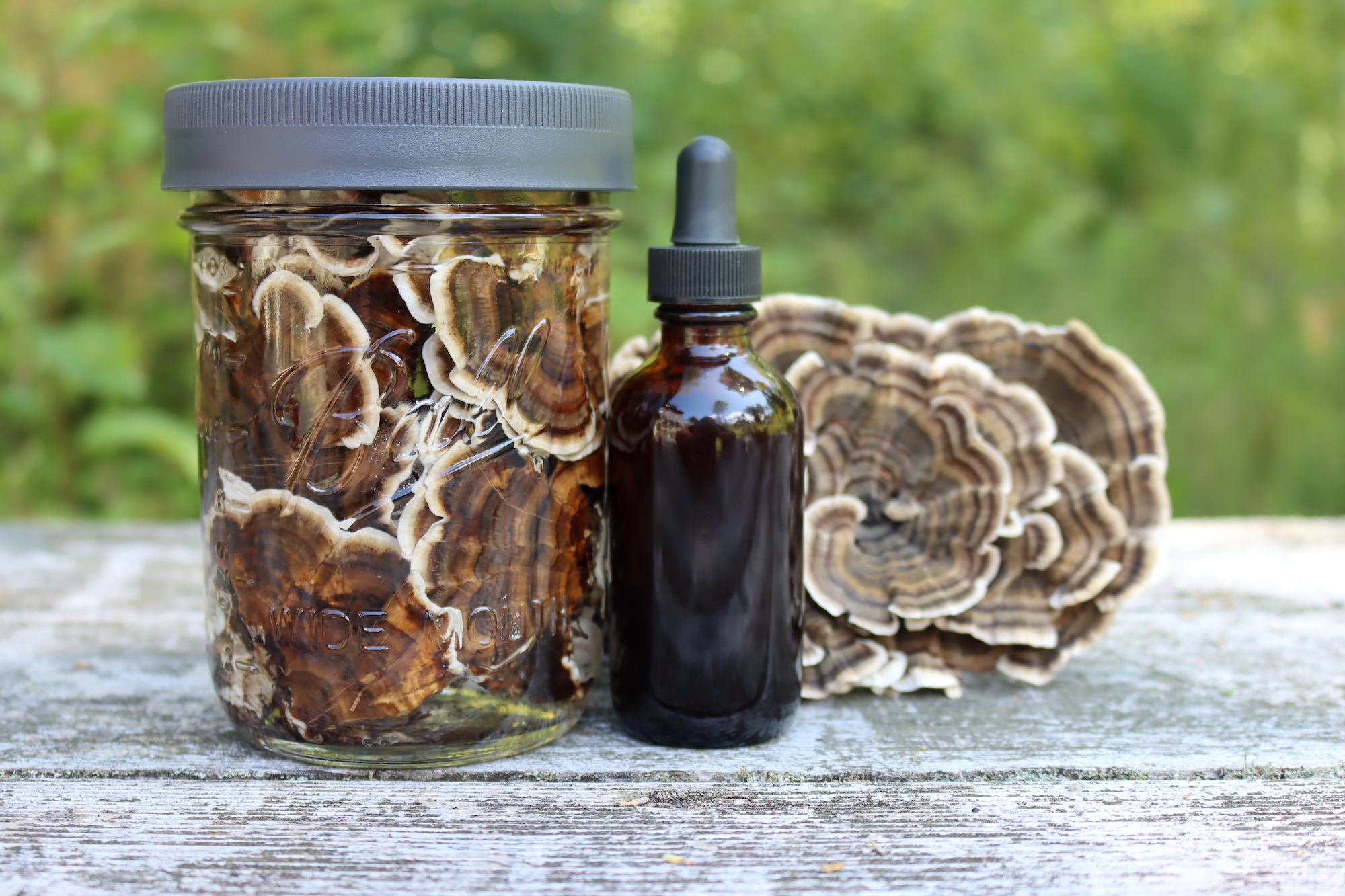
Turkey tail mushroom is the go-to mushroom when you need a boost.
Whether you’re stressed, sick, or just have a hectic life, turkey tail may come to your aid. It’s rich in antioxidants, supports the immune system and gut health, may improve energy levels, and supports healthy skin.
There’s some evidence that turkey tail may have more serious implications in the medical world, too. Turkey tail may be helpful in fighting cancer and helping people recover from chemotherapy and other cancer treatments.
Turkey tail is a beautiful, common polypore mushroom. Part of its Latin name, “versicolor” is Latin for “of several colors” and refers to the mushroom’s striking, concentric zones of different colors, including rust, blackish, dark green, gray-brown, and gray-blue. The name “turkey tail” refers to its resemblance to a turkey’s tail.
These mushrooms are widespread and grow throughout North America, Europe, and Asia. It usually grows in overlapping clusters and forms on the dead stumps and rotting logs of hardwood trees.
When identifying turkey tail mushrooms, key features to note are the bands of color with the outer band being the lightest, whitish-yellow pores on the underside, and a leathery texture. Turkey tail mushrooms have a white spore print.
Never use mushrooms for which you are not 100% certain of their identification. Local and online foraging and plant groups and walks are great resources, as are mushroom field guides. If available, go with someone who knows how to identify turkey tail on your first foraging foray.
Thanks to an increased interest in herbalism and mushroom cultivation, you can now find turkey tail mushroom spores or kits available. You can cultivate turkey tail inside your house with a kit or out in your own woodland with the spores.
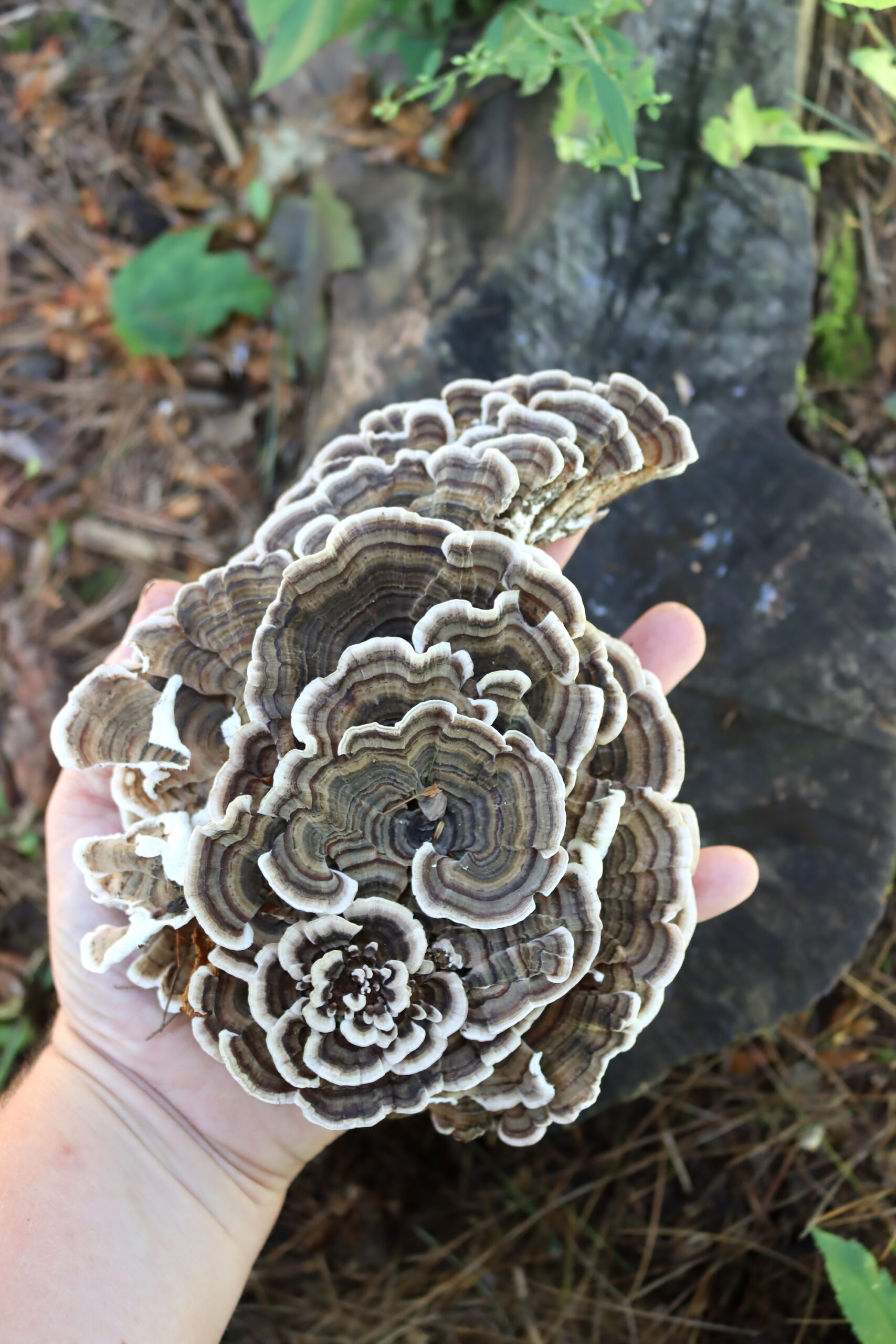
Turkey Tail Mushroom Tincture Uses
Herbalists use turkey tail mushroom tincture internally to treat various ailments. It also has some limited use as a topical herbal remedy.
Topically, turkey tail mushroom tincture is used for:
- Reducing Inflammation
Internally, turkey tail mushroom tincture is used to:
- Boost the Immune System
- Support Digestive Health
- Promote Healthy Skin
- Support Cancer Treatments
Additionally, the herb is currently being investigated for its potential:
- Anti-Cancer Properties
- Boost Energy Levels
In these cases, research is ongoing, and more work is needed to establish whether or not the benefits are scientifically significant.
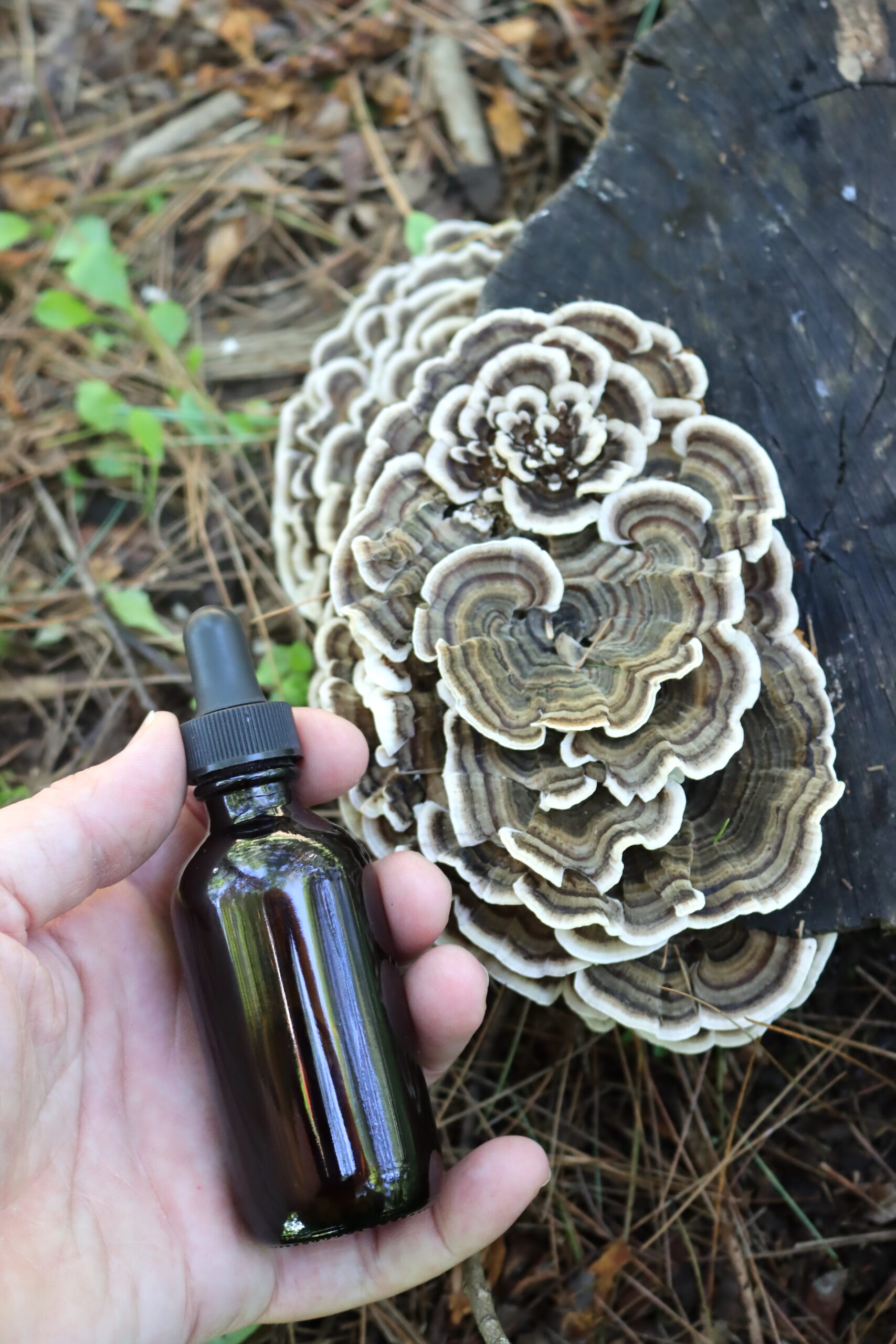
Benefits of Turkey Tail Tincture
In traditional medicine, turkey tail mushrooms are often thought of as immune boosters. Today, we know that they contain two important compounds called polysaccharopeptide (PSP) and polysaccharide-K (PSK). These compounds may help boost the immune system, especially when it comes to fighting cancer.
A 2017 study found that PSP has a stimulating effect on immune cell populations, especially when combined with other cancer treatments. While a 2011 study found that PSK stimulates dendritic cells that boost the immune response.
Turkey tail is also rich in antioxidants, including phenols and flavonoids, which help reduce cell damage from oxidative stress. In a 2017 study, researchers examined turkey tail mushrooms’ antioxidant content and found that they contain the flavanoid antioxidants quercetin and baicalein, along with 35 different phenols!
These same compounds and antioxidants that allow turkey tail mushrooms to boost our immune system and protect us from cancer and other illnesses may also help protect our skin and reduce inflammation.
Turkey tail mushrooms may also play a role in immunity by helping maintain a healthy balance of gut bacteria. A 2013 test-tube study on gut bacteria found that turkey tail mushrooms reduced the populations of bad bacteria like Clostridium and Staphylococcus and increased the populations of good bacteria like Bifidobacterium and Lactobacillus. Both of these good bacteria types have been linked to strong immune systems, good digestion, and lower risk of some types of cancer.
There’s also some evidence that this powerful immune booster may also improve your energy levels. In a 2017 study on mice, those mice given turkey tail mushroom had reduced signs of fatigue and increased levels of forelimb strength after exercise compared to the placebo group. Interestingly, the mice receiving turkey tail also had lower blood sugar levels at rest than those mice in the placebo group.
You should avoid taking turkey tail mushrooms if you have a mushroom or fungus allergy. If you have diabetes or are on diabetes medication, consult your physician before taking turkey tail. Turkey tail may cause blood sugar levels to dip too low in individuals being treated for diabetes.
The dosage of turkey tail mushroom tincture varies with the intended use. Generally, herbalists recommend one to two droppers full daily. You can also use the tincture topically as needed.
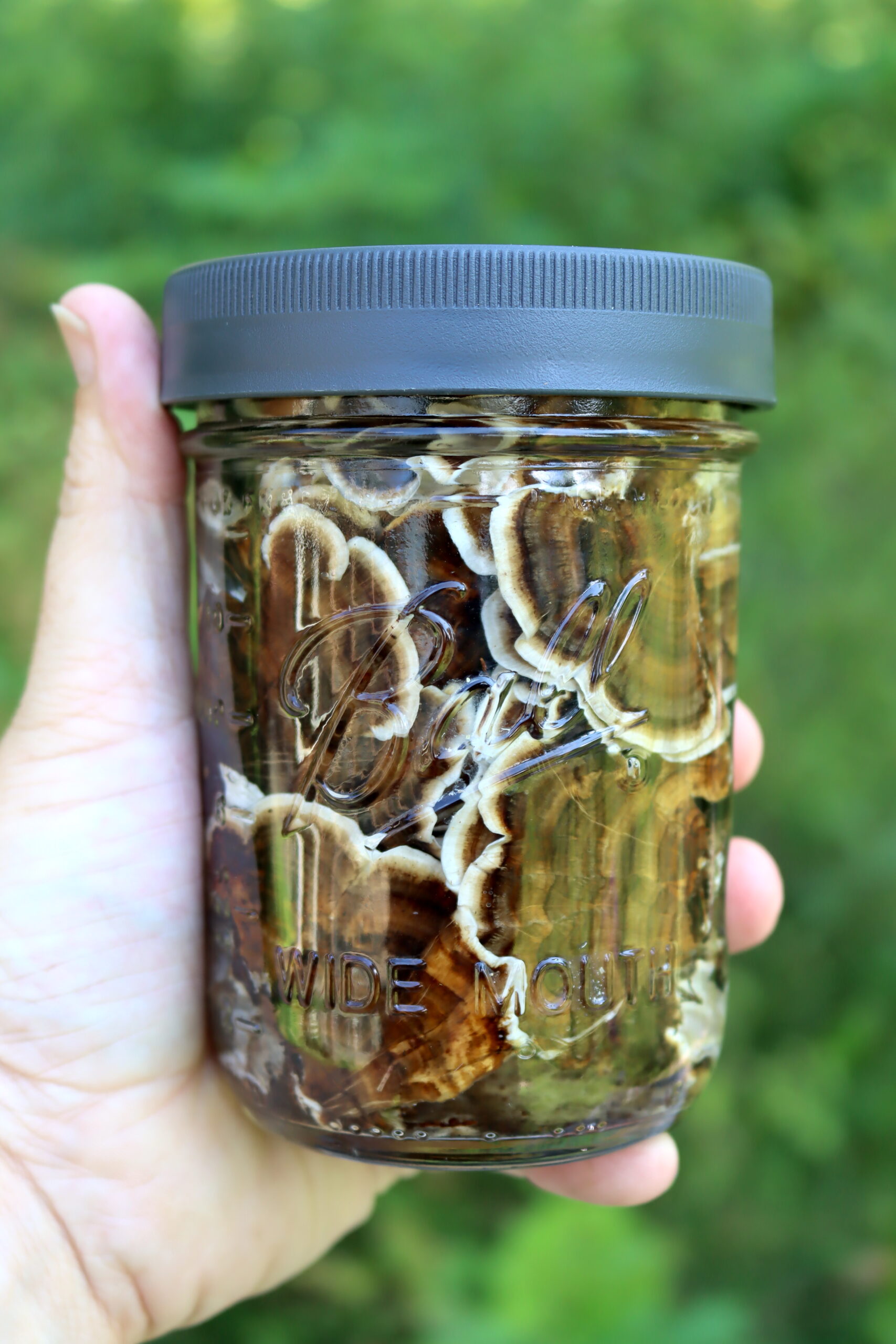
Parts Used for Tincture
To make a turkey tail mushroom tincture, you’ll need to harvest the whole mushroom. Try to harvest them when they’re fresh and colorful. Older, dried, faded mushrooms that are past their prime will not be as effective.
Make sure you correctly identify the mushroom you are harvesting. There are turkey tail mushroom lookalikes!
After harvesting, you want to dehydrate or dry the turkey tail mushrooms for this tincture. You can let them air dry out of direct sunlight or use a dehydrator for faster results.
If you’re not comfortable foraging for turkey tail mushrooms or are unable to find any near you, you can order dried turkey tail mushrooms online from reputable herbal suppliers like Mountain Rose Herbs.
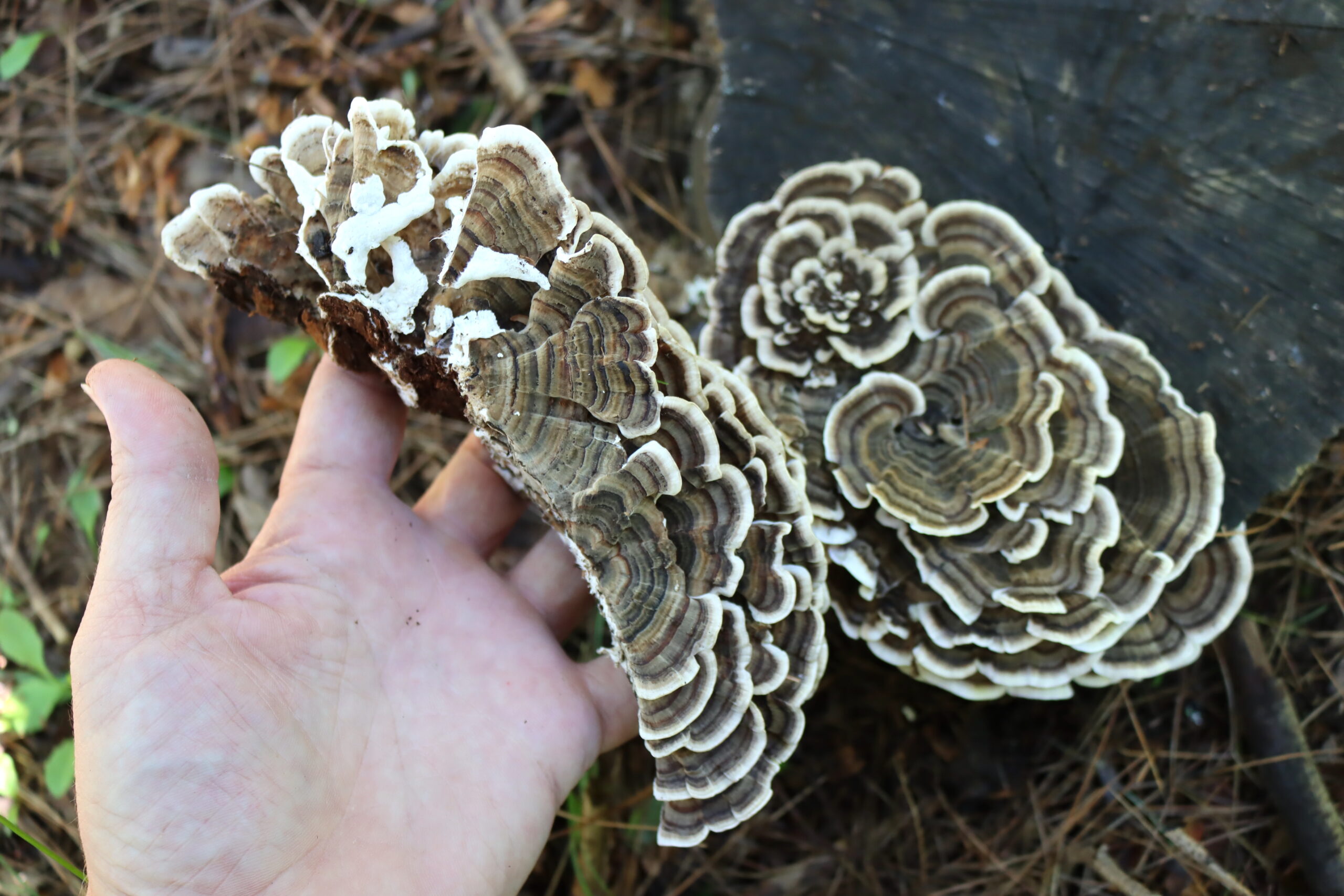
How to Make Turkey Tail Mushroom Tincture
Making a turkey tail mushroom tincture is a bit different than a typical herbal tincture because turkey tail mushrooms contain both alcohol-soluble compounds called triterpenes and water-soluble compounds called beta-glucans.
To ensure we get turkey tail’s full goodness and harvest both of these types of compounds, we’ll need to complete a double extraction. Don’t worry, it’s not as scary as it sounds!
Like a normal tincture, we’ll end with a shelf-stable product that’s easy to use.
To make a turkey tail mushroom tincture, you’ll need the following ingredients and equipment:
- Dried Turkey Tail Mushrooms
- Alcohol that’s 80 proof/40% or higher – I use vodka, but you can choose whatever suits you
- Spring water or filtered water
- Two one-quart mason jars with lids
- One-gallon stockpot
- Funnel
- Cheesecloth
- Fine mesh sieve
- Amber glass tincture bottles (with dropper)
**Never use isopropyl/rubbing alcohol for tinctures (or any other remedy you plan on ingesting). Even in small amounts, this type of alcohol is toxic and meant for external applications only.
We begin this process similar to how we make traditional tinctures. Fill your mason jar about ½ full with dried mushrooms.
Then, fill the mason jar with the alcohol of your choice until all the mushrooms are submerged. Leave about ½ inch of head space.

Now, you can set your developing tincture aside for about one month. Shake it once or more daily during this period. It’s okay if you miss a couple of days; tinctures are quite forgiving.
After a month, you’re ready for the next step. Strain your turkey-tail-infused alcohol into another clean mason jar and set it aside. I use cheesecloth and a funnel for this, but you can also use a fine mesh sieve. Don’t compost the mushrooms! Just set them to the side. We need them again soon.
Measure the alcohol mixture at this point. The total amount is important, as that determines how much you’ll need to cook the mushroom tea to get the right ratio for a shelf stable finished extract.
In a stockpot, bring ½ gallon of your filtered or spring water to a boil. Once it’s boiling, add your mushrooms from the previous step.
Reduce the heat and simmer for about 2 hours until the water has reduced to 8 to 16 ounces (1 to 2 cups). Keep an eye on the water throughout the 2 hours, and add more water if it evaporates too quickly.
After two hours, remove the pot from the stove and let the water cool. Then, strain out the mushrooms.
Continue to cook the mushroom “tea” until it’s about 1/4 the volume of your alcohol tincture. For example, if you have 2 cups of finished alcohol extract, you’ll want about 1/2 cup of water extract.
If you keep to this ratio, despite adding water, this extract should still contain between 25% and 35% alcohol, which keeps it shelf stable like a typical tincture.
Once the water extract is cool, combine your turkey-tail-infused alcohol with your turkey-tail-infused water to create a shelf-stable turkey-tail mushroom double extract!
Pour your double extract into amber tincture bottles and label each bottle with the name, date, and dosage of your tincture. There’s no need to get fancy; I recommend using a small piece of masking tape and a marker. It peels off easily when I’m ready to use the bottle for something else.
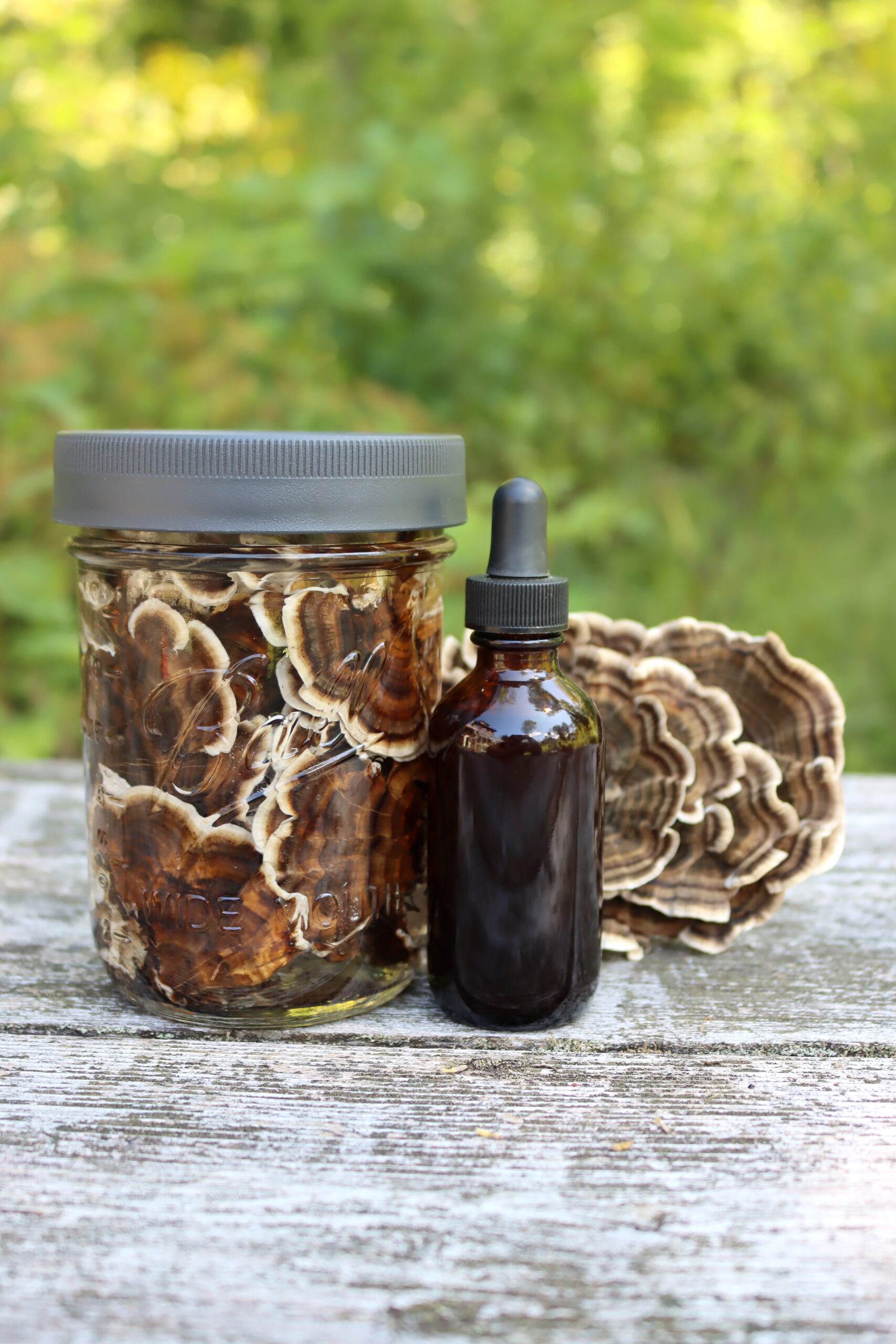
Turkey Tail Mushroom Tincture Dosage
I’d suggest consulting a clinical herbalist to get a specific dosage for your body and needs. This is especially critical if you are currently being treated for a major illness like cancer.
Generally, herbalists recommend one to two droppers full of turkey tail mushroom tincture daily. You can also use the tincture topically for skin health. Use clean cotton balls, cloth, or gauze to gently swab the turkey tail mushroom tincture onto the affected area.
Turkey Tail Mushroom Formulations
Herbalists frequently pair turkey tail mushroom tincture with other mushroom tinctures. Good choices are Chaga tincture and Reishi tincture, which can help provide a powerful immune boost. Lion’s mane and reishi can both help reduce anxiety and stress and are great choices if you’re struggling with the mental toll of illness. Maitake tincture may also help boost the immune system and fight cancer.
Turkey tail mushrooms are also often combined with other classic immunity herbs. Good options include elderberry tincture, oregano tincture, or echinacea tincture.
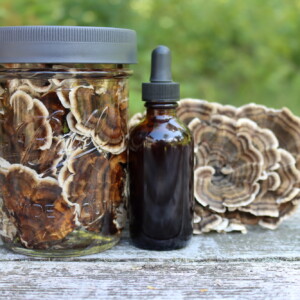
Turkey Tail Mushroom Tincture
Equipment
Ingredients
- Turkey Tail Mushrooms
- Neutral Spirit such as vodka*
Instructions
- Fill a clean, empty mason jar 3/4 full of fresh turkey tail mushrooms or 1/2 full of dried turkey tail mushrooms.
- Cover the fresh or dried turkey tail mushrooms with alcohol, making sure the contents of the jar are completely covered.
- Screw the lid on tightly and gently shake the contents of the jar. Place in a cool, dry location away from light, allowing the extraction to occur over the next month to 6 weeks.
- Give the contents of the jar a gentle shake every couple of days.
- Keep an eye on the alcohol level, adding more alcohol to cover the mushrooms if needed.
- After a month, you’re ready for the next step. Strain your turkey-tail-infused alcohol into another clean mason jar and set it aside. I use cheesecloth and a funnel for this, but you can also use a fine mesh sieve. Don’t compost the mushrooms! Just set them to the side. We need them again soon.
- Measure the alcohol mixture at this point. The total amount is important, as that determines how much you'll need to cook the mushroom tea to get the right ratio for a shelf stable finished extract.
- In a stockpot, bring ½ gallon of your filtered or spring water to a boil. Once it’s boiling, add your mushrooms from the previous step.
- Reduce the heat and simmer for about 2 hours until the water has reduced to 8 to 16 ounces (1 to 2 cups). Keep an eye on the water throughout the 2 hours, and add more water if it evaporates too quickly.
- After two hours, remove the pot from the stove and let the water cool. Then, strain out the mushrooms.
- Continue to cook the mushroom "tea" until it's about 1/4 the volume of your alcohol tincture. For example, if you have 2 cups of finished alcohol extract, you'll want about 1/2 cup of water extract.
- If you keep to this ratio, despite adding water, this extract should still contain between 25% and 35% alcohol, which keeps it shelf stable like a typical tincture.
- Once the water extract is cool, combine your turkey-tail-infused alcohol with your turkey-tail-infused water to create a shelf-stable turkey-tail mushroom double extract!
- Pour your double extract into amber tincture bottles and label each bottle with the name, date, and dosage of your tincture. There’s no need to get fancy; I recommend using a small piece of masking tape and a marker. It peels off easily when I'm ready to use the bottle for something else.
Notes
Medicinal Mushroom Tinctures
Looking for more medicinal mushroom tinctures?
- Reishi Mushroom Tincture
- Chaga Tincture
- Birch Polypore Tincture
- Turkey Tail Tincture
- Shiitake Mushroom Tincture (Coming Soon)
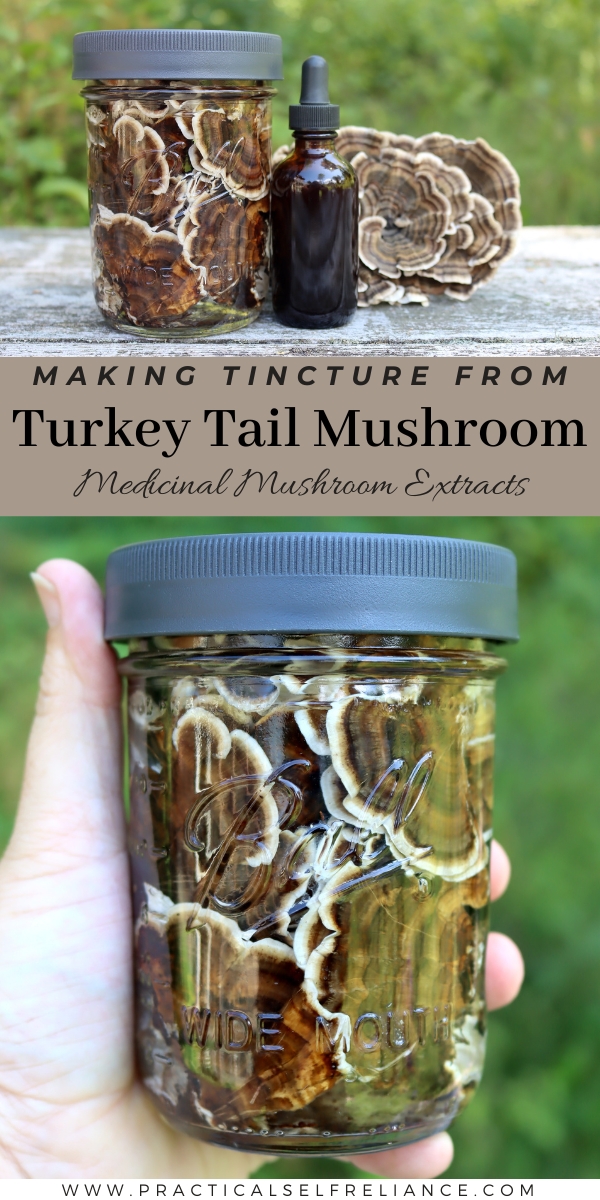
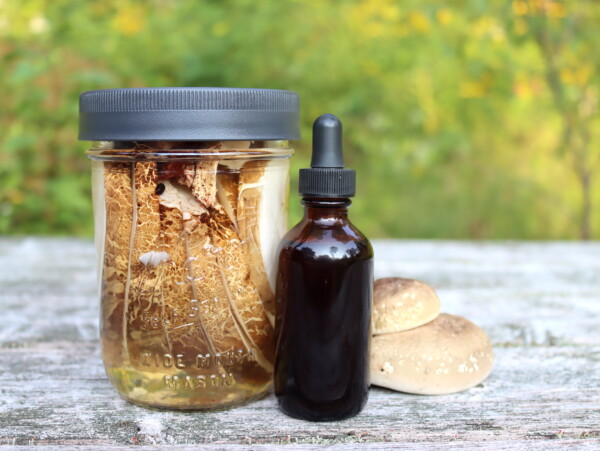
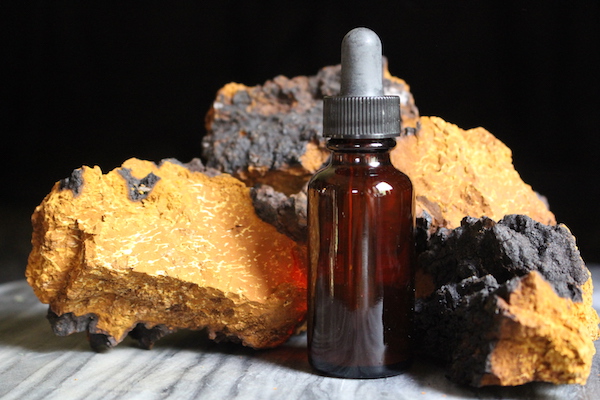
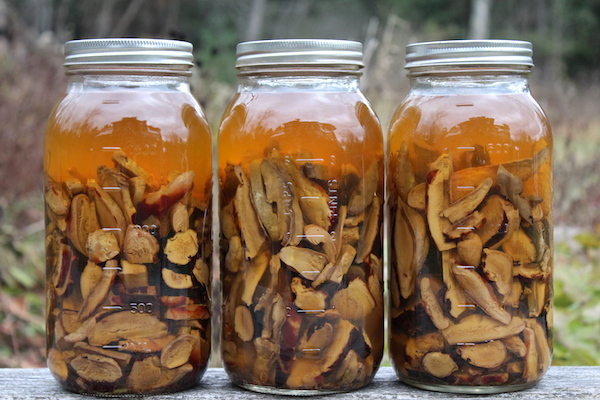










Do you think I could use glycerine instead of alcohol?
You can use glycerine, just be aware that a lot of the beneficial constituents in mushrooms are only soluble in alcohol.